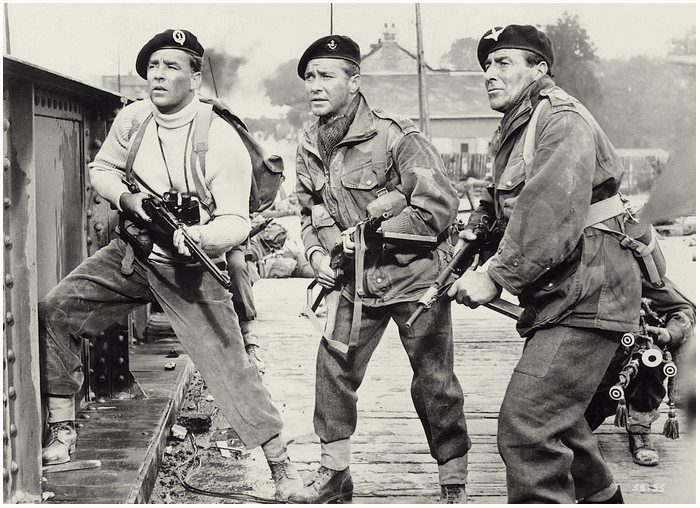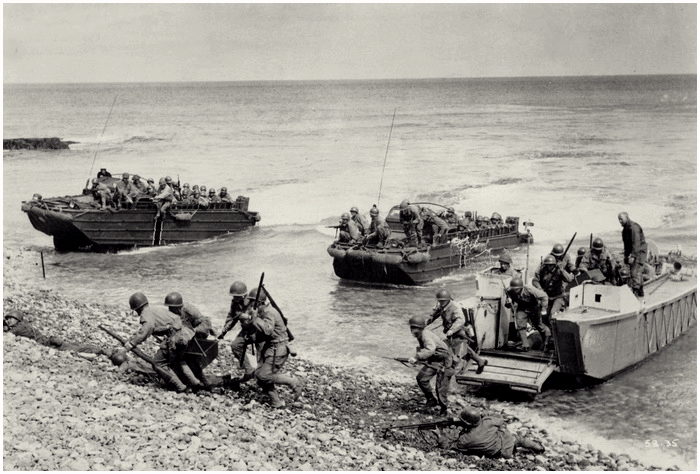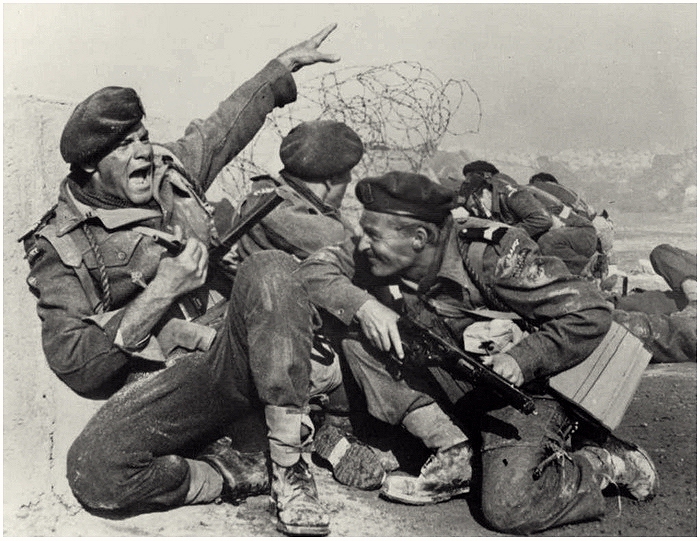Pegasus Bridge

While one team is filming at the cliffs of Pointe du
Hoc, another team is working at the Caen canal, near
Benouville. Here is the re-enactment of the attack on
the so called Pegasus Bridge.
The landing with the Horsa gliders is brought in a spectacular way,
and is a great action opener at the start of D-Day. This was a text book
act by the British paratroopers in the first hour of June 6, 1944.

Operation Deadstick, the attack has begon,...
Actor Richard Todd, as Major John Howard, plays an important roll in ‘The Longest Day’.
Todd was born on June 11, 1919, in Ireland. His childhood was in India, where is father was
an army doctor. When the family returns to West Devon,
England, Richard goes to the military school at Sandhurst. A career as
a writers lies ahead, but he finally becomes an actor at Italia Conta school. When the Second
World War starts, Richard Todd joins the 7th Parachute Battalion, part of the 6th Airborne Division.
He jumps east of the Orne river, in Normandy, just before 01.00 hours, on June 6t, 1944. As relief
troops he and other para’s head for the two bridges over the Orne and the Caen canal (Pegasus bridge).
During the night Todd runs into Lt. Sweeney at the Pegasus Bridge, who captured with his men the Orne
bridge. Sweeney had just captured Major Hans Schmidt when he approached the bridge. As a commander who
was given the order to protect the bridges, Schmidt asked to be shot on the spot (his request was denied).

From left to right: Peter Lawford, Lord Lovat,
Richard Todd and John Howard.
(Behind Peter Lawford is the large monument of Pegasus Bridge, hidden behind sandbags)
A week earlier, during a exercise, Todd and Sweeney, had also run into each other. When
they introduced themselves, it went like this, Lt.
Sweeney: "I met this chap on the bridge and he said,… "Hello,
my name is Todd and they call me Sweeney",… So I replied,…
"Hello, my name is Sweeney and they call me Tod!" (Richard Todd played
once the roll of Sweeney Tod, a murderess barber). Richard Todd would never have guessed,
that in 17 years time, in 1961, he would be once again standing on the bridge, now as an
actor to portray Major John Howard who was given the order:
'Hold,… until relieved'. It has to be Richard Todd his 'twilight-zone' moment.

Left, Peter Lawford (Lord Lovat)
and in the middle Richard Todd (John Howard)
The ‘relieve’ for Howard had to come from Lord Lovat and his troops, who had landed
on SWORD Beach, and were legging it towards Pegasus Bridge. Before the shooting of the scenes
were started at Pegasus Bridge, producer Zanuck had Lord Lovat and Major John Howard brought
over to meet the men who were going to portray them. The men had not seen each other since Jun 6,
1944. Richard Todd played Howard, Lord Lovat was done by Peter Lawford.
Battery de
Longues-sur-Mer
(as 'Widerstandneste 60')

Major
Pluskat is shocked to see the invasion
fleet
A very impressive scène is when Major Pluskat (Hans
Christian Blech) the invasion fleet observes coming at
him through the morning haze. The unbelief that the
Allies has brought so much ships under his coast almost
makes you pity for the poor Pluskat. You feel more sorry
for him when his commander does not believe him, even
when he screams at him during the bombardment. The scène
was shot in a studio, but the scène outside are made
around the directionfinder casemat of Longues-sur-Mer.

The
directionfinder casemat of the battery from
Longues-sur-Mer
The real
location at Ste Honorine des Pertes was not suitable.
The Battery de Longues was also used as a complex near Caen, when that is ‘attacked’
by puppets (‘Rupert’) dressed as paratroopers and ‘loaded’ with explosives (squibs) who were dropped as decoy.
Pointe du
Hoc

The filmcrew at work on Pointe du Hoc
After shooting completed at Ste-Mere-Eglise the crew
left for Pointe du Hoc.
The 'set-decorators' had
little to do at this place. Everything was unchanged
since June 1944. To protect the actors against the
upcoming tide, they had a huge crane that operated a
large platform that could move the 'Rangers' up and down
(just as the camera crew). The Rangers in the movie are not wearing their
distinctive blue shoulder patch. Other details are correct, like the British crews onboard the LCA that
brings the Rangers to the shore, they have the correct helmets.

Actors
Robert Wagner and Paul Anka had to climb the steep cliff
together with real US Rangers, such as Joseph Lowe.
Hij was er in het echt ook bij geweest op 6 juni 1944. After the struggle to reach the top the
terrain is cleared of German oposition. These are some exiting scènes. Steven Spielberg would
later use one of the scènes for Saving Private Ryan. When German soldiers want to surrender, a Rangers shoots them.
He seems not to know what;...'Bitte, bitte!' means.

Robert Wagner is wounded,
(the Rangers on
the left will shoot in a moment the 'Bitte, bitte'- Germans).
The
same bunker today, with the exception of the S-35 tankturret

He is hardly noticed between all the other stars in this movie, but
George Segal has a small part in 'The Longest Day'. The reason for his appearance is that
this is just his second movie. Segal, born in 1924, started his career late. He was 31 one when he took
up acting, after finnishing Columbia College of Columbia University in 1955. But his career took
of after his appearance in 'Who's Afraid
of Virginia Woolf?' which brought him an Oscar nomination. Segal made a couple of war movies, most at the start of his
career, such as: 'King Rat' (1965), 'Lost Command' (1966),
and his most populair one; 'The Bridge at Remagen' (1969).

George Segal te nameless US Ranger with the BAR
In 'The Longest Day' George Segal is an US Army Ranger that we see climbing against the cliff.
He has a BAR (Browning Automatic Rifle), and when he fires it during the climb on a ladder, the recoil almost
pussing hem backwards towards the sea. Segal is the first to enter a large casemate to discover there are no
guns to be found,... was this operation all for nothing?

Port-en-Bessin (Ouistreham)
Ouistreham was completely rebuilt after the destruction in June 1944.
Everything had changed and the
production team moved to Port-en-Bessin to film the
battle for the casino over there.
What Zanuck not was told, the casino at the time was torn down
by the Germans, to have a clear field, where they dug trenches
and built bunkers. When Zanuck realized this mistake, he ignored it.
On the edge of the
harbour of Port-en-Bessin they built a construction that
represented the casino with a heavy gun in the basement.
The building was constructed in such a way that it would
collapse in three phases.
 The Casino, the set for Ouistreham in 'The Longest Day', in Port-en-Bessin
The Casino, the set for Ouistreham in 'The Longest Day', in Port-en-Bessin
(click on the picture for how it looked in Ouistreham before the war)
The great scene, the attack
on the Casino in ‘The Longest Day’, was filmed from a helicopter. Several shots
were made, but not the one that ‘grabbed’ the moment. And all the while the people
of Port-en-Bessin had to stay indoors for various hours. When director Ken Annakin
stepped into the making of this scene, the shot was made in one go. The shot, which
lasts four minutes, is beautiful orchestrated. During the finally, the set of 12.000
English pounds was totally destroyed.

On the
left was the set of the 'casino',
on the right the block of houses
where the commando´s were pinned down
A detail for the one who wants to know everything; as Kieffer collects a Sherman tank ,
he returns with a later type, an M4A1 76mm, not used during D-Day. It's a minor mistake,
but they made also a DD tank out of it, when the canvas screen was upright, the barrel
of the gun would be far to long.
For a documentary, made a couple of years after the shooting of ‘The Longest Day’,
we see producer Zanuck return to Port-en-Bessin. Even now, he keeps the illusion up that
we are in ‘Ouistreham’. He even has a interview, in dreadful French, with the mayor of
‘Ouistreham’. The mayor also declares how magnificent everything was during the filming.

Commander
of the Free French Commando's, Phillipe Kieffer,
was played by
Christian Marquand (left)
The part for the Free French Commando's, Com. Phillipe Kieffer,
was played by Christian Marquand. Were the other Allied actors
tough guys, and nice to look at, the German cast were mostly
cliché puppets who play Germans with disbelief. The biggest caricature
has to be Heinz Reincke in his role as the German pilot
'Pips' Priller. exceptions were Hans Christian Blech as Major Werner Pluskat and Wolfgang
Preiss as Major Generaal Max Pemsel. But they managed to make an honest movie
of the drama of D-Day. To let the actors speak in their own language,
English, German or French, it gives the picture a greater authenticity.
For the next chapter
CLICK BELOW ON THE ‘CRICKETS’
|